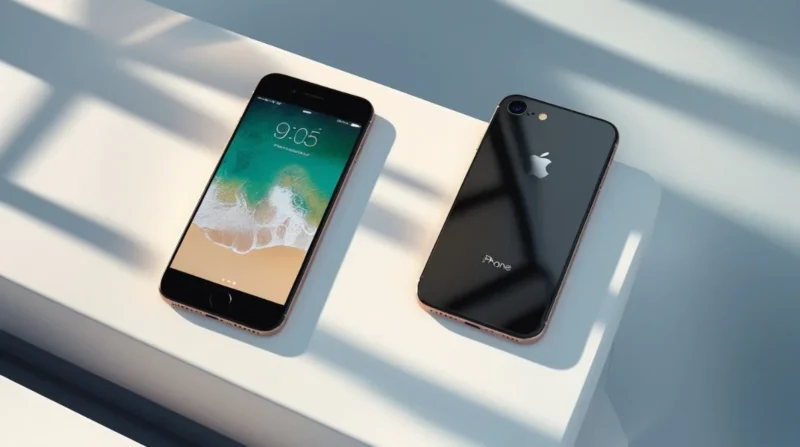Table of Contents
- How Good Was the iPhone 8 When It First Released?
- Design and Build Quality
- Performance and Software Support
- Battery Life
- Camera Capabilities
- Connectivity and Features
- Pricing and Availability
- Pros and Cons
- How Does the iPhone 8 Perform in 2025?
- How Many People Still Use the iPhone 8?
- What Percentage of iPhone 8 Phones Have Issues?
- Final Thoughts on Buying the iPhone 8 in 2025
The iPhone 8, launched in 2017, was once a flagship device boasting a sleek design and reliable performance. Fast forward to 2025, and many are questioning its relevance in today’s tech landscape. Let’s discuss whether the iPhone 8 still holds its ground.
How Good Was the iPhone 8 When It First Released?
When the iPhone 8 first came out, it was one of the best phones on the market. It was fast enough to handle the latest apps and games without any lag, and its camera took sharp, vibrant photos even in low light. The wireless charging feature was new for iPhones, making it convenient for users. At that time, it was priced as a flagship phone and many people wanted it because it balanced power with a smaller, comfortable size.
Design and Build Quality
The iPhone 8 features a 4.7-inch Retina HD display with True Tone technology, encased in a glass front and back with an aluminum frame. Its compact size and Touch ID home button offer a familiar and comfortable user experience, especially for those who prefer smaller phones.
Performance and Software Support
Powered by the A11 Bionic chip, the iPhone 8 handles everyday tasks like browsing, messaging, and streaming smoothly. However, it’s important to note that Apple has ceased major iOS updates for this model, with iOS 16 being its last supported version. This means users won’t receive new features or enhancements introduced in iOS 17 and beyond.
Battery Life
The iPhone 8’s battery can last a full day with moderate use. However, as the device ages, battery degradation is inevitable. Users have reported quicker battery drain and the need for more frequent charging. Replacing the battery can rejuvenate its longevity, but it’s an additional cost to consider.
Camera Capabilities
Equipped with a 12MP rear camera and a 7MP front camera, the iPhone 8 captures decent photos and videos. While it lacks the advanced features of newer models, such as Night Mode or multiple lenses, it still performs adequately for casual photography.
Connectivity and Features
The iPhone 8 supports 4G LTE but doesn’t offer 5G connectivity, which is becoming more prevalent in 2025. It also lacks features like Face ID and MagSafe, present in newer iPhones. However, it does support wireless charging and retains the beloved Touch ID.
Pricing and Availability
As of 2025, the iPhone 8 is no longer sold directly by Apple but is available through third-party sellers and refurbished markets. Prices vary based on condition and storage capacity, but it’s generally an affordable option for those on a budget.
Pros and Cons
Pros
- Compact and familiar design.
- Reliable performance for basic tasks.
- Affordable pricing in the secondary market.
- Supports wireless charging and Touch ID.
Cons
- No longer receives major iOS updates.
- Lacks 5G connectivity.
- The battery may require replacement.
- Limited camera features compared to newer models.
How Does the iPhone 8 Perform in 2025?
Now, in 2025, the iPhone 8 has become quite old in terms of technology. While it can still run many apps and do basic tasks like calling, texting, and web browsing, it can’t keep up with newer phones when it comes to speed, camera quality, or software features.
Apple stopped supporting the iPhone 8 with the latest iOS updates, so it won’t get new features or security patches, which can affect its performance and safety.
Many users also notice that the battery doesn’t last as long as it used to. Battery degradation is a common problem in older phones, and the iPhone 8 is no exception. Without replacing the battery, the phone may shut down unexpectedly or need frequent charging.
How Many People Still Use the iPhone 8?
Despite being almost 8 years old, the iPhone 8 is still used by a significant number of people worldwide. According to recent surveys and market data, around 5-7% of iPhone users still own an iPhone 8 or 8 Plus model. This shows that many people either prefer its smaller size or use it as a backup phone because of its simplicity and reliable build.
What Percentage of iPhone 8 Phones Have Issues?
Because of age and wear, a good number of iPhone 8 devices experience problems like:
- Battery degradation: About 30-40% of iPhone 8 users report needing a battery replacement or experiencing fast battery drain.
- Performance slowdowns: Around 20-25% notice the phone becoming slower or freezing during use.
- Hardware issues: Some users face problems with the Touch ID sensor, charging port, or screen after heavy use, though this is less common.
Despite these issues, many users find that replacing the battery or repairing minor faults can extend the phone’s life by another year or two.
Final Thoughts on Buying the iPhone 8 in 2025
The iPhone 8 remains a solid choice for those who want a budget-friendly iPhone with reliable performance for everyday use. While it may not have the latest technology or features, it still gets the job done for calls, messages, and simple apps. If you’re looking for a basic phone without breaking the bank, the iPhone 8 can be a practical pick. However, if you want future-proof features and longer software updates, exploring newer models might be a better investment. Ultimately, it depends on what matters most to you, affordability and familiarity, or cutting-edge tech.









